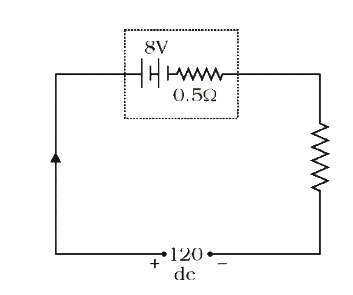A battery of EMF 10 V, with internal resistance 1Ω is being charged by a 120 V d.c. supply using a series resistance of 10Ω. The terminal voltage of the battery is
20 V
10 V
Zero
30 V
The correct Answer is:A
To find the terminal voltage of the battery being charged, we can follow these steps:
Step 1: Identify the given values
- EMF of the battery (E) = 10 V
- Internal resistance of the battery (r) = 1 Ω
- External resistance (R) = 10 Ω
- Supply voltage (V_s) = 120 V
Step 2: Calculate the total resistance in the circuit
The total resistance in the circuit is the sum of the internal resistance of the battery and the external resistance:
Rtotal=R+r=10Ω+1Ω=11Ω
Step 3: Calculate the current in the circuit
Using Ohm's law, we can find the current (I) flowing through the circuit. The net voltage across the circuit is the supply voltage minus the EMF of the battery:
I=Vs−ERtotal
Substituting the values:
I=120V−10V11Ω=110V11Ω=10A
Step 4: Calculate the terminal voltage of the battery
The terminal voltage (V) of the battery when it is being charged can be calculated using the formula:
V=E+I⋅r
Substituting the values:
V=10V+(10A⋅1Ω)=10V+10V=20V
Conclusion
The terminal voltage of the battery is 20 V.
---
- EMF of the battery (E) = 10 V
- Internal resistance of the battery (r) = 1 Ω
- External resistance (R) = 10 Ω
- Supply voltage (V_s) = 120 V
The total resistance in the circuit is the sum of the internal resistance of the battery and the external resistance:
Rtotal=R+r=10Ω+1Ω=11Ω
Using Ohm's law, we can find the current (I) flowing through the circuit. The net voltage across the circuit is the supply voltage minus the EMF of the battery:
I=Vs−ERtotal
Substituting the values:
I=120V−10V11Ω=110V11Ω=10A
The terminal voltage (V) of the battery when it is being charged can be calculated using the formula:
V=E+I⋅r
Substituting the values:
V=10V+(10A⋅1Ω)=10V+10V=20V
The terminal voltage of the battery is 20 V.
Topper's Solved these Questions
Similar Questions
A storage battery of emf 8.0 V and internal resistance 0.5Ω is being charged by a 120V dc supply using a series resistor of 15.5Ω what in the terminal voltage of the battery during charging ? What is the purpose of having a series resistor in the charging circuit?
View SolutionA storage battery of emf 8.0 V and internal resistance 0.5 Ω is being charged by a 120 Ω d.c. supply using a series resistor of 15.5 Ω . What is the terminal voltage of the battery during charging ? What is the purpose of having a series resistor in the charging circuit ?
View Solution
Knowledge Check
A battery of emf 8 V with internal resistance 0.5Ω is being charged by a 120 V dc supply using a series resistance of 15.5Ω. The terminal voltage of the battery is
A20.5 VB15.5 VC11.5 VD2.5 V
A storage battery of emf 8V and internal resistance is being charged by a 120 V D.C. supply using a series resistor of What is the terminal voltage of the battery during charging? What is the purpose of having a series resistor in the charging circuit?

View SolutionA storage battery of emf 8V and internal resistance is being charged by a 120 V D.C. supply using a series resistor of What is the terminal voltage of the battery during charging? What is the purpose of having a series resistor in the charging circuit?

View Solution(i) A storage battery of emf 8V, internal resistance 1Ω is being charged by a 120V d.c. source using a 15Ω resistor in series in the circuit. Calculate the current in the circuit (ii) terminal voltage across the battery during charging and (ii) chemical energy stored in the battery in 5 minutes.
View SolutionA storage battery of emf 8V, internal resistance 1Ω, is being charged by a 120V d.c. source, using a 15Ω resistor in series in the circuit. Calculate (i) the current in the circuit. (ii) terminal voltage across the battery during charging, and (iii) chemical energy stored in the battery in 5 minutes?
View SolutionA storage battery of emf 12V and internal resistance of 1.5Ω is being charged by a 12 V supply. How much resistance is to be put in series for charging the battery safely, be maintaining a constant charging current of 6 A.
View SolutionA cell of emf 4V and internal resistance 1Ω is being charged by DC source of 10V through resistor of 5Ω .Calculate the terminal voltage across the cell -
View SolutionA battery of six cells each of e.m.f . 2V and internal resistance 0.5Ω is being charged by D.C. mains of e.m.f. 220V by using an external resistance of 10Ω. What is the potential difference across the battery?
View Solution